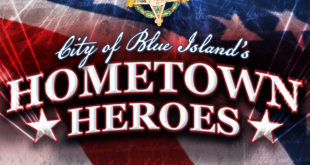In Illinois, on any given week we could see blue skies, thunderstorms and torrential rainfall. The changing weather is second nature to many of us, but as the calendar flips from winter to spring, it is important to not become complacent about severe weather threats that exist in our state. As part of Severe Weather Preparedness Month, the Illinois Emergency Management Agency (IEMA) and the National Weather Service (NWS) have teamed up to publish a Severe Weather Preparedness Guide to help Illinoisans be better prepared when severe weather strikes.
“Making people aware of weather hazards and how to prepare for them, is just step one. Using the information and applying protective measures in an emergency takes practice. This month, the Illinois Emergency Management Agency is encouraging families, businesses, schools and communities to build a kit, practice your plan and be better prepared,” said IEMA Director Alicia Tate-Nadeau.
The National Weather Service will be recognizing Severe Weather Preparedness Week during the week of March 1-5. During this week, Illinoisans are encouraged to:
• Make a severe weather preparedness plan
• Build an emergency preparedness kit
• Identify your safe place to during a storm
• Familiarize yourself the various weather watches/warnings/advisories
The National Weather Service (NWS) is responsible for issuing severe weather watches, warnings and advisories to alert the public when dangerous weather conditions are expected. Educating yourself and your family about these various terms, and the associated protective measures, can help keep you and your family safe. This year, the NWS added two new terms to this Severe Weather Preparedness Guide: Tornado Emergency and Flash Flood Emergency.
“It is so important to know the difference between a watch and warning when it comes to tornadoes, severe thunderstorms and floods.” said Chris Miller with the National Weather Service in Lincoln, Illinois. “In rare situations, an emergency can be issued for tornadoes and flash floods. This is when a confirmed, violent tornado or significant flood creates an imminent danger to life and property. Act immediately to save your life.”
Thunderstorms can produce damaging winds, deadly lightning, large hail, flash flooding and tornadoes. On average, Illinois will see 53 tornadoes each year with nearly 20-percent occurring at night. For a number of reasons, tornadoes that occur at night are twice as likely to result in fatalities.
The National Weather Service and state and local emergency management officials strongly encourage people to have a National Oceanic and Atmospheric Administration (NOAA) All Hazards Weather Radio with battery backup. These radios can be programmed to receive alerts for specified counties to keep you and your family apprised of impending weather and post-event information for all types of hazards including natural (earthquakes), environmental (chemical spills) and public safety hazards (AMBER alerts). When an alert is issued for the programmed area, the device will sound a warning alarm tone followed by the essential information.
“The information provided in these alerts will guide you through the appropriate protective measures. Watches mean that severe weather or flooding might develop near your area over the next several hours. Be ready to act if storms approach. When a warning is issued, a storm has a history of producing damage or flooding, or is expected to develop in your area shortly. We are warning you to take action immediately,” said Miller.
In this day and age of families constantly on the go, it is also critical for people to have multiple ways to receive notifications and updated information about severe weather warnings. FEMA offers a FREE mobile app that provides fast and reliable weather alerts from the National Weather Service (NWS). The app can be tailored to offer alerts for up to five different locations nationwide. The mobile app can also help you locate open shelters and disaster resource centers near you in the event of an emergency.
In addition to NOAA weather radios, Wireless Emergency Alerts (WEA) can provide lifesaving information about impending storms and emergencies. These alerts can be sent to your mobile device without the need to download an app or subscribe to a service. Not only are these tools critical to surviving overnight storms, but they can be extremely beneficial for those who travel.
For more information about what to do before, during and after a storm, please visit www.Ready.Illinois.gov.
 City of Blue Island Think Outside the Loop
City of Blue Island Think Outside the Loop




